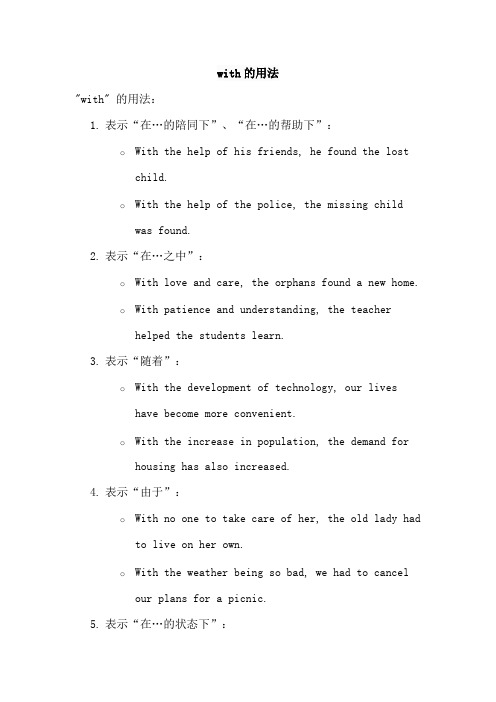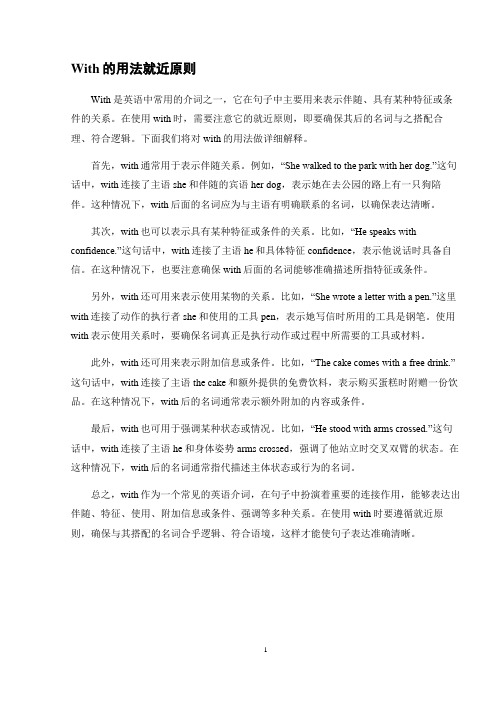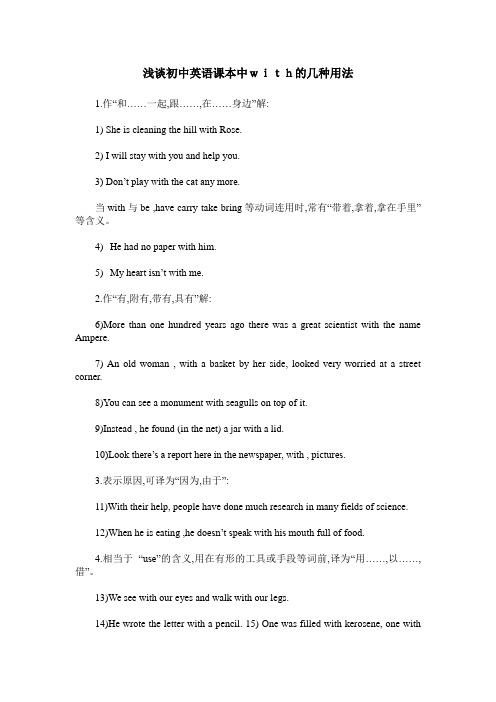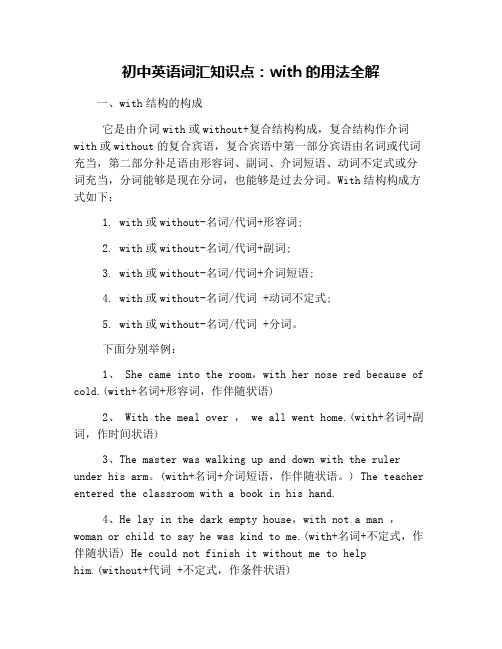With的用法全解
with表用的用法

with的用法"with" 的用法:1.表示“在…的陪同下”、“在…的帮助下”:o With the help of his friends, he found the lost child.o With the help of the police, the missing child was found.2.表示“在…之中”:o With love and care, the orphans found a new home.o With patience and understanding, the teacherhelped the students learn.3.表示“随着”:o With the development of technology, our lives have become more convenient.o With the increase in population, the demand for housing has also increased.4.表示“由于”:o With no one to take care of her, the old lady had to live on her own.o With the weather being so bad, we had to cancel our plans for a picnic.5.表示“在…的状态下”:o With the car in good condition, we decided to go for a long drive.o With the lights off, it was very dark in the room.6.表示“以…方式”:o With a smile on her face, she greeted her guests warmly.o With a pen in his hand, he started writing a letter.。
with的用法和例句

with的用法和例句with有用;随着;包括;和 ... 一起等意思,那么你知道with的用法吗?下面跟着店铺一起来学习一下,希望对大家的学习有所帮助!with的用法大全:with的用法1:with表示状态时,还可作“跟上…”“听懂…的话”解,一般用于疑问句或否定句中。
with的用法2:with表示关系时还可作“与…合并〔混合,组合〕”解。
with的用法3:with表示伴随状态时,作“以与…同样的方向〔程度,比率〕”解。
可接“名词+动词不定式”“名词+现在分词”“名词+过去分词”。
with的用法4:with表示比较时作“同…相比”“与…平行”解。
with的用法5:with可以用来表示虚拟语气,意思是“如果,假如”。
用于诗歌或民谣的副歌、叠句中, with常无实际含意。
with的用法例句:1. Beauty is an attitude. It has nothing to do with age.美是一种态度,与年龄无关。
2. If you're not satisfied with the life you're living, don't just complain. Do something about it.对于现况的不满,不能只是抱怨,要有勇气作出改变。
3. He was well acquainted with the literature of France, Germany and Holland.他对于法国、德国和荷兰的文学了如指掌。
4. I thought I'd enrol you with an art group at the school.我想我会吸收你参加学校的一个艺术团。
5. Somehow Karin managed to cope with the demands of her career.卡琳设法达到了其职业的要求。
6. She ran away with a man called McTavish last year.去年,她和一个叫麦克塔维什的男人私奔了。
with的用法就近原则

With的用法就近原则With是英语中常用的介词之一,它在句子中主要用来表示伴随、具有某种特征或条件的关系。
在使用with时,需要注意它的就近原则,即要确保其后的名词与之搭配合理、符合逻辑。
下面我们将对with的用法做详细解释。
首先,with通常用于表示伴随关系。
例如,“She walked to the park with her dog.”这句话中,with连接了主语she和伴随的宾语her dog,表示她在去公园的路上有一只狗陪伴。
这种情况下,with后面的名词应为与主语有明确联系的名词,以确保表达清晰。
其次,with也可以表示具有某种特征或条件的关系。
比如,“He speaks with confidence.”这句话中,with连接了主语he和具体特征confidence,表示他说话时具备自信。
在这种情况下,也要注意确保with后面的名词能够准确描述所指特征或条件。
另外,with还可用来表示使用某物的关系。
比如,“She wrote a letter with a pen.”这里with连接了动作的执行者she和使用的工具pen,表示她写信时所用的工具是钢笔。
使用with表示使用关系时,要确保名词真正是执行动作或过程中所需要的工具或材料。
此外,with还可用来表示附加信息或条件。
比如,“The cake comes with a free drink.”这句话中,with连接了主语the cake和额外提供的免费饮料,表示购买蛋糕时附赠一份饮品。
在这种情况下,with后的名词通常表示额外附加的内容或条件。
最后,with也可用于强调某种状态或情况。
比如,“He stood with arms crossed.”这句话中,with连接了主语he和身体姿势arms crossed,强调了他站立时交叉双臂的状态。
在这种情况下,with后的名词通常指代描述主体状态或行为的名词。
总之,with作为一个常见的英语介词,在句子中扮演着重要的连接作用,能够表达出伴随、特征、使用、附加信息或条件、强调等多种关系。
with的复合结构,最全解说

with结构也称为with复合结构,是由with+复合宾语(宾语+宾语补足语)组成一. with复合结构在句中做状语,表示谓语动作发生的伴随情况、时间、原因、方式等.其构成有下列几种情形:1、with + 名词 (或代词) + 现在分词此时,现在分词和前面的名词或代词是逻辑上的主谓关系.例如:With prices going up so fast,we can't afford luxuries.由于物价上涨很快,我们买不起高档商品.(原因状语)With the crowds cheering,they drove to the palace.在人群的欢呼声中,他们驱车来到皇宫.(伴随情况) With the bay leading the way,I found the village easily.2、with + 名词 (或代词) + 过去分词此时,过去分词和前面的名词或代词是逻辑上的动宾关系.例如:I sat in my room for a few minutes with my eyes fixed on the ceiling.我在房间坐了一会儿,眼睛盯着天花板.(伴随情况)She had to walk home with her bike stolen.自行车被偷,她只好步行回家.(原因状语)3、with + 名词 (或代词) + 形容词I like to sleep with the windows open.我喜欢把窗户开着睡觉.(伴随情况)With the weather so close and stuffy,ten to one it'll rain presently.大气这样闷,十之八九要下雨.(原因状语)4、with + 名词 (或代词) + 介词短语With the children at school,we can't take our vacation when we want to.由于孩子们在上学,所以当我们想度假时而不能去度假.(原因状语)The professor came in with a book in his hand(伴随状语)5、with + 名词 (或代词) + 副词He fell asleep with the light on.他睡着了,灯还亮着.(伴随情况)The boy stood there with his head down.这个男孩低头站在那儿.(伴随情况)John was lying on the bed with all his clothes on.6 、with + 名词 (或代词) + 动词不定式此时,不定式表示将发生的动作.例如:With no one to talk to,John felt miserable.由于没人可以说话的人,约翰感到很悲哀.(原因状语)With a lot of work to do,he wasn't allowed to go out.因为还有很多工作要做,他没有被允许外出.(原因状语)在with without 的复合结构中,多数情况下with 能省略,但without 不能省略。
高中英语教学热点易混点详解之With的复合结构

高中英语教学热点易混点详解之With的复合结构英语中的with复合结构也叫“with+复合宾语”结构,即with+宾语+宾语补足语。
其用法归纳如下:“with+复合宾语结构”按其构成可分为:1、with+宾语+介词短语1).English lessons are broadcast every day on the radio with explanations in English and other languages.广播电台每天播放英语课程,并用英语或其他语言进行解说。
2).BBCEnglish broadcasts programmes for China with explanations in Chinese.BBC英语对中国广播的节目是用汉语进行解释的。
2、with+宾语+现在分词1).The Yangtze River is very busy with so many boats and ships coming and going every day.每天长江上各种船只来来往往显得格外忙碌。
2).The young woman,with a baby sleeping in her arms,was wandering in the street.那位年轻妇女,怀抱一个熟睡的婴儿,漫步在大街上。
3、with+宾语+过去分词1).The boy was crying with the toy broken.玩具破了,那男孩在哭。
2).You should go to sleep with the light turned off.你应该把灯熄了再睡。
4、with+宾语+动词不定式1).With so many essays to write,he won’t have time to go shopping this morning.他有那么多文章要写,今天没有时间去买东西。
with的用法总结(通用8篇)

with的用法总结with的用法总结(通用8篇)总结是把一定阶段内的有关情况分析研究,做出有指导性的经验方法以及结论的书面材料,它能帮我们理顺知识结构,突出重点,突破难点,因此好好准备一份总结吧。
那么总结要注意有什么内容呢?以下是小编收集整理的with的用法总结,欢迎阅读与收藏。
with的用法总结篇1一、with或without+名词/代词+形容词例句:1.I like to sleep with the windows open.我喜欢把窗户开着睡觉。
(伴随情况)2.With the weather so close and stuffy, ten to one itll rain presently.大气这样闷,十之_要下雨(原因状语)二、with或without+名词/代词+副词例句:1.She left the room with all the lights on.她离开了房间,灯还亮着。
(伴随情况)2.The boy stood there with his head down.这个男孩低头站在那儿。
(伴随情况)三、with或without+名词/代词+介词短语例句:1.He walked into the dark street with a stick in his hand.他走进黑暗的街道时手里拿着根棍子。
(伴随情况)2.With the children at school, we cant take our vacation when we want to.由于孩子们在上学,所以当我们想度假时而不能去度假。
(原因状语)四、with或without+名词/代词+非谓语动词1、with或without+名词/代词+动词不定式,此时,不定式表示将发生的动作。
例句:1.With no one to talk to, John felt miserable.由于没人可以说话的人,约翰感到很悲哀。
浅谈初中英语课本中with的几种用法

浅谈初中英语课本中with的几种用法1.作“和……一起,跟……,在……身边”解:1) She is cleaning the hill with Rose.2) I will stay with you and help you.3) Don’t play with the cat any more.当with与be ,have carry take bring等动词连用时,常有“带着,拿着,拿在手里”等含义。
4) He had no paper with him.5) My he art isn’t with me.2.作“有,附有,带有,具有”解:6)More than one hundred years ago there was a great scientist with the name Ampere.7) An old woman , with a basket by her side, looked very worried at a street corner.8)You can see a monument with seagulls on top of it.9)Instead , he found (in the net) a jar with a lid.10)Look there’s a report here in the newspaper, with , pictures.3.表示原因,可译为“因为,由于”:11)With their help, people have done much research in many fields of science.12)When he is eating ,he d oesn’t speak with his mouth full of food.4.相当于“use”的含义,用在有形的工具或手段等词前,译为“用……,以……,借”。
初中英语词汇知识点:with的用法全解

初中英语词汇知识点:with的用法全解一、with结构的构成它是由介词with或without+复合结构构成,复合结构作介词with或without的复合宾语,复合宾语中第一部分宾语由名词或代词充当,第二部分补足语由形容词、副词、介词短语、动词不定式或分词充当,分词能够是现在分词,也能够是过去分词。
With结构构成方式如下:1. with或without-名词/代词+形容词;2. with或without-名词/代词+副词;3. with或without-名词/代词+介词短语;4. with或without-名词/代词 +动词不定式;5. with或without-名词/代词 +分词。
下面分别举例:1、 She came into the room,with her nose red because of cold.(with+名词+形容词,作伴随状语)2、 With the meal over , we all went home.(with+名词+副词,作时间状语)3、The master was walking up and down with the ruler under his arm。
(with+名词+介词短语,作伴随状语。
) The teacher entered the classroom with a book in his hand.4、He lay in the dark empty house,with not a man ,woman or child to say he was kind to me.(with+名词+不定式,作伴随状语) He could not finish it without me to helphim.(without+代词 +不定式,作条件状语)5、She fell asleep with the light burning.(with+名词+现在分词,作伴随状语) Without anything left in the with结构是很多英语复合结构中最常用的一种。
- 1、下载文档前请自行甄别文档内容的完整性,平台不提供额外的编辑、内容补充、找答案等附加服务。
- 2、"仅部分预览"的文档,不可在线预览部分如存在完整性等问题,可反馈申请退款(可完整预览的文档不适用该条件!)。
- 3、如文档侵犯您的权益,请联系客服反馈,我们会尽快为您处理(人工客服工作时间:9:00-18:30)。
With的用法全解
with结构是许多英语复合结构中最常用的一种。
学好它对学好复合宾语结构、
不定式复合结构、动名词复合结构和独立主格结构均能起很重要的作用。
本文就此的构成、特点及用法等作一较全面阐述,以帮助同学们掌握这一重要的语法知识。
一、 with结构的构成
它是由介词with或without+复合结构构成,复合结构作介词with或without的复合宾语,复合宾语中第一部分宾语由名词或代词充当,第二部分补足语由形容词、副词、介词短语、动词不定式或分词充当,分词可以是现在分词,也可以是过去分词。
With结构构成方式如下:
1. with或without-名词/代词+形容词;
2. with或without-名词/代词+副词;
3. with或without-名词/代词+介词短语;
4. with或without-名词/代词 +动词不定式;
5. with或without-名词/代词 +分词。
下面分别举例:
1、 She came into the room,with her nose red because of cold.(with+名词+形容词,作伴随状语)
2、 With the meal over , we all went home.(with+名词+副词,作时间状语)
3、The master was walking up and down with the ruler under his arm。
(with+名词+介词短语,作伴随状语。
) The teacher entered the classroom with a book in his hand.
4、He lay in the dark empty house,with not a man ,woman or child to say he was kind to me.(with+名词+不定式,作伴随状语)He could not finish it without me to help him.(without+代词 +不定式,作条件状语)
5、She fell asleep with the light burning.(with+名词+现在分词,作伴随状语) Without anything left in the with结构是许多英
语复合结构中最常用的一种。
学好它对学好复合宾语结构、不定式复合结构、动名词复合结构和独立主格结构均能起很重要的作用。
本文就此的构成、特点及用法等作一较全面阐述,以帮助同学们掌握这一重要的语法知识。
二、with结构的用法
with是介词,其意义颇多,一时难掌握。
为帮助大家理清头绪,以教材中的句子为例,进行分类,并配以简单的解释。
在句子中with结构多数充当状语,表示行为方式,伴随情况、时间、原因或条件(详见上述例句)。
1.带着,牵着…… (表动作特征)。
如:
Run with the kite like this.
2.附加、附带着……(表事物特征)。
如:
A glass of apple juice, two glasses of coke, two hamburgers with potato chips, rice and fish.
3.和…… (某人)一起。
a. 跟某人一起(居住、吃、喝、玩、交谈……) 。
如:
Now I am in China with my parents.
Sometimes we go out to eat with our friends.
He / She's talking with a friend.
b. 跟go, come 连用,有 "加入"到某方的意思。
如:
Do you want to come with me?
4.和play一起构成短语动词play
with 意为"玩耍……,玩弄……" 如:
Two boys are playing with their yo-yos.
5.与help 一起构成 help...with...句式,意为"帮助 (某人) 做 (某事)"。
如:
On Monday and Wednesday, he helps his friends with their English.
6.表示面部神情,有“含着……,带着……” 如:
"I'm late for school," said Sun Yang, with tears in his eyes.
7.表示 "用……" 如:
You play it with your feet.
What do the farmers do with your machines?
8.表示 "对……,关于……"。
如:
What's wrong with it?
There's something wrong with my computer.
三、with结构的特点
1. with结构由介词with或without+复合结构构成。
复合结构中第一部分与第二部分语法上是宾语和宾语补足语关系,而在逻辑上,却具有主谓关系,也就是说,可以用第一部分作主语,第二部分作谓语,构成一个句子。
例如: With him taken care of,we felt quite relieved.(欣慰)→(He was taken good care of.)She fell asleep with the light burning. →(The light was burning.) With her hair gone,there could be no use for them. →(Her hair was gone.)
2.在with结构中,第一部分为人称代词时,则该用宾格代词。
例如: He could not finish it without me to help him.
四、几点重要的考点说明
1. with结构在句子中的位置: with 结构在句中作状语,表示时间、条件、原因时一般放在句子前面,并用逗号与句子分开;表示方式和伴随状况时一般放在句子后面,不用逗号分开。
若with结构作定语,则放在所修饰的名词之后,一般不用逗号隔开。
2. with结构作状语时,不定式、现在分词、和过去分词的区别:在with结构中,不定式、现在分词作宾补,表示主动,但是不定式表示将要发生的动作,而现在分词表示正在发生或发生了的动作;过去分词表示被动或完成。
例如: With the boy leading the way,we found he house easily.(小男孩已领过路)
With the boy to lead the way,we will find the house easily tomorrow.(小男孩明天将领路)
He lay on the bed with the bedroom door shut.(寝室被关着)
3. with结构与一般的with短语的区别: with结构具有上述功能和特点,而"介词with+名词或代词(组)"组成的一般的with短语在句子中可以作定语和状语。
作状语时,它能表示动作的方式、原因,但不能表示时间、伴随和条件。
在一般的with短语中,with后面所跟的不是复合结构,也根本没有逻辑上的主谓关系。
4. with结构与独立主格结构的关系: with结构属于独立主格结构,但在结构上,with结构由介词with或without引导,名词前有冠词、形容词、所
有格代词或其它词类所修饰,结构较松散;而独立主格结构没有with或without引导,结构严密,名词前可用可不用修饰语。
在句法功能上,with
结构可以作定语,独立主格结构则不能;独立主格结构通常在句中作状语,但也可以作主语,而with结构则不能。
独立主格在口语中不常用,往往由一个从句代替,而with结构较口语化,较常用。
例如:
There were rows of white houses with trees in front of them.("with+复合宾语"结构,在句中作定语)
A strong man working a whole day could not jump this high.(名词+现在分词构成的独立主格结构,作主语)
The boy said,turning to the man,his eyes opened wide and his hand raised.(独立主格结构,表示伴随状况或行为方式,作状语)
Then last night,I followed him here,and climbed in,sword in hand.(名词+介词短语构成的独立主格结构,作状语,表示伴随情况)board, she went out to get something to eat.(without+代词+过去分词,作为原因状语)。
